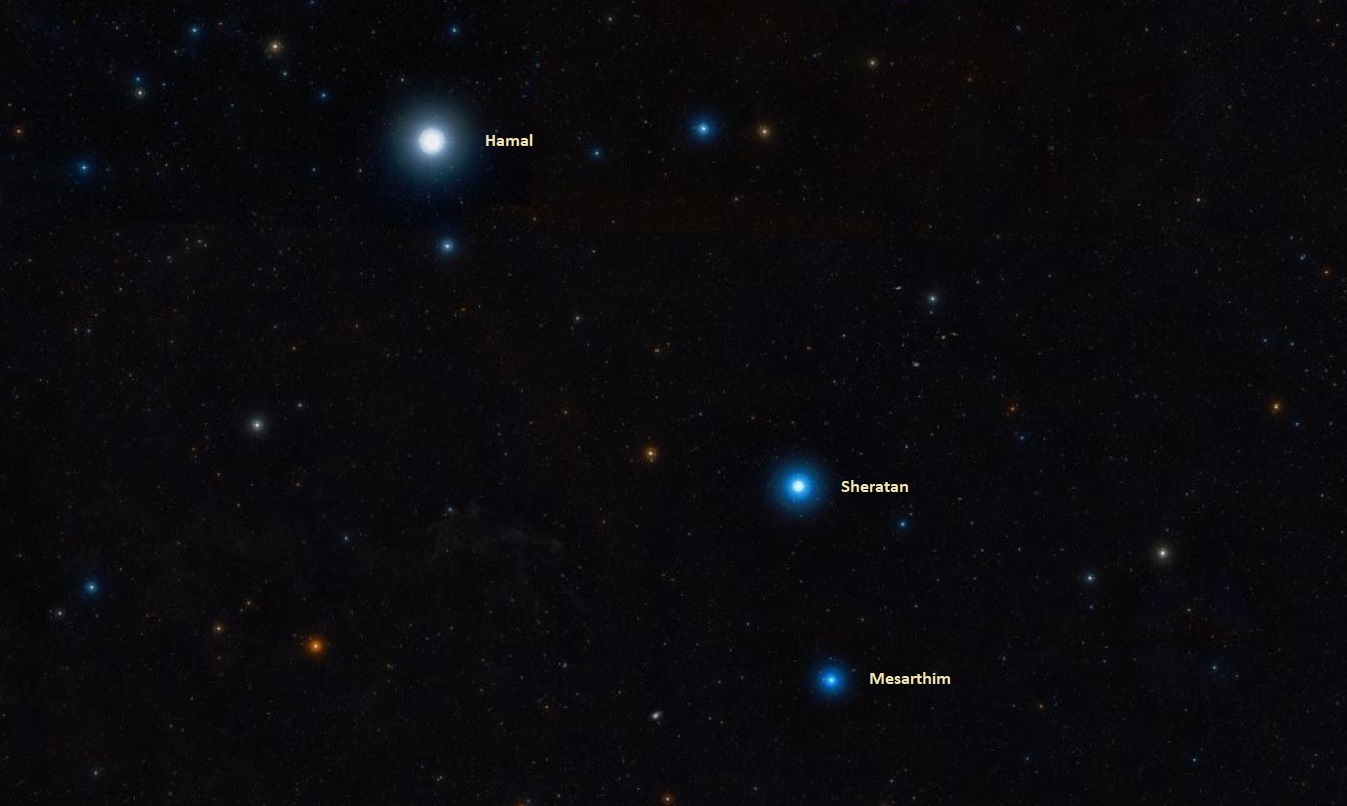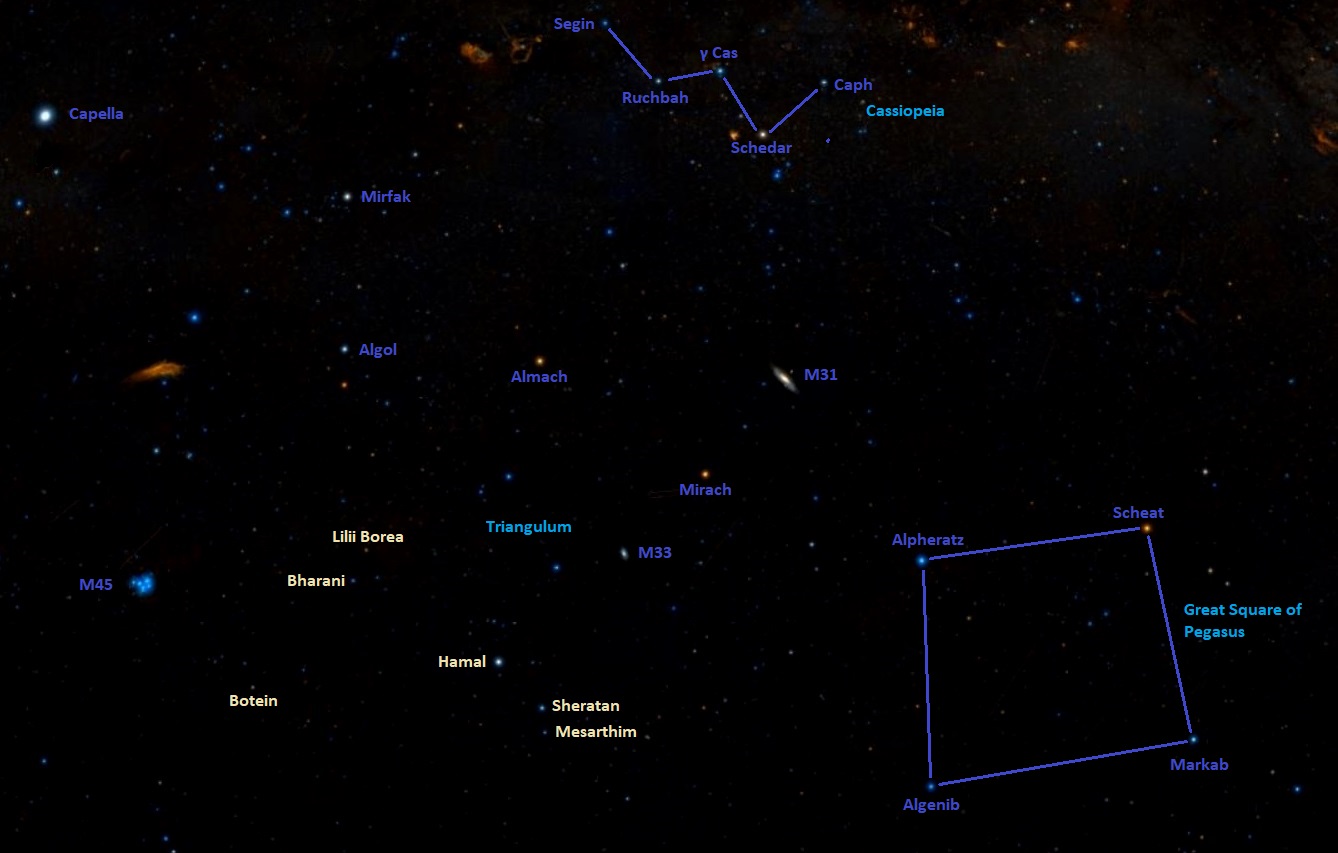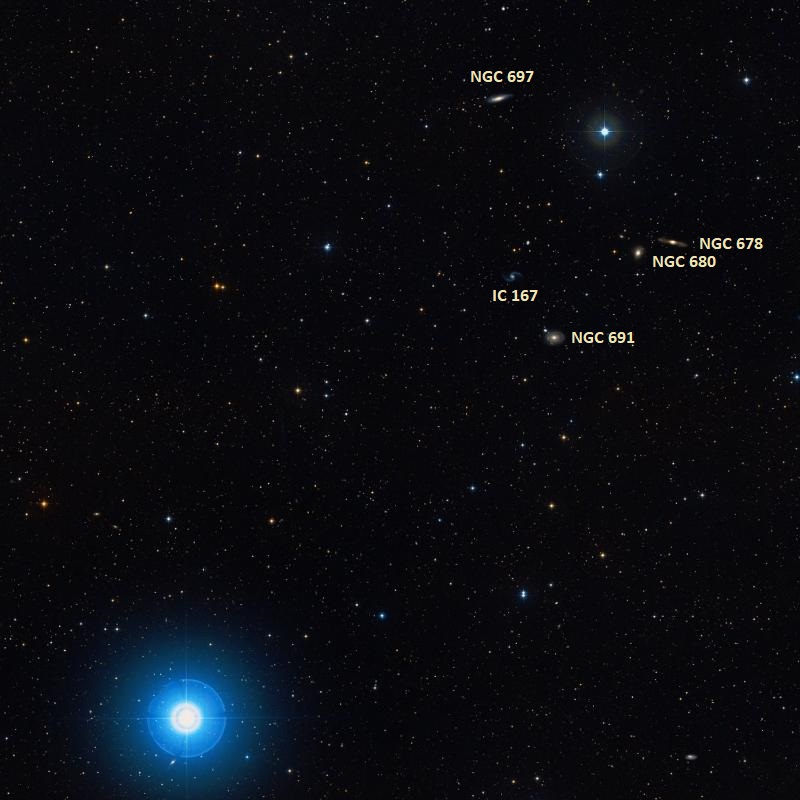Sheratan, Beta Arietis (β Ari), is a spectroscopic binary star located in the constellation Aries. It lies at a distance of 59.6 light years from Earth. With an apparent magnitude of 2.655, it is the second brightest star in Aries, after Hamal. Sheratan and its neighbour Mesarthim mark one of the celestial Ram’s horns. The two stars were important in antiquity because of their proximity to the northern spring equinox, also known as the First Point of Aries.
Star system
The Beta Arietis system consists of two stars locked in a tight, highly elliptical orbit with a period of 106.9954 ± 0.0005 days and an average distance of 0.64 astronomical units. As they orbit, they come within 0.08 astronomical units of each other and drift as far apart as 1.2 astronomical units.
Beta Arietis is a spectroscopic binary system, which means that the two individual components cannot be resolved with a conventional telescope. However, their orbit and masses were computed after observations with the Mark III Stellar Interferometer at the Mount Wilson Observatory.
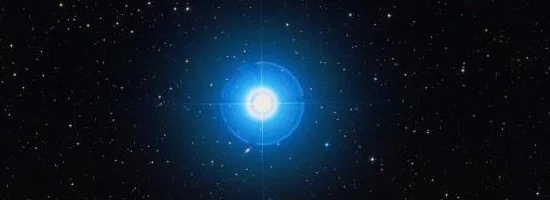
Sheratan (Beta Arietis), image: Wikisky
The primary component, Beta Arietis A, is a main sequence star of the spectral type A5 V, still fusing hydrogen to helium in its core. It may be a mild metallic-line star, a class A star with strong absorption lines of metals (zinc, strontium, barium and others) and deficiencies of other elements, like calcium or scandium. Sheratan shows a spectrum similar to that of an F2 IV star, but has narrow hydrogen and ionized calcium lines. However, as the star’s absorption lines are broadened as a result of the Doppler effect caused by rotation, it is difficult to determine the abundance patterns.
Sheratan has a mass 2.34 times that of the Sun and its estimated age is 0.3 billion years. With a surface temperature of about 9,000 K, it is 23 times more luminous than the Sun. It is a relatively fast spinner, with a projected rotational velocity of 73 km/s. In a few million years, the star will evolve into a red giant and, as it does, it will transfer a considerable amount of mass to the companion.
Sheratan is not massive enough to go out as a supernova. When it reaches the end of its life, it will cast off its outer layers as a planetary nebula and eventually fade away as a dim white dwarf. At that point, the faint companion will be the more massive component in the system.
The companion, Beta Arietis B, has a luminosity 1.3 times that of the Sun and is roughly four magnitudes fainter than Beta Arietis A. The star’s spectrum has not been determined because it is too close to the more luminous primary component. However, based on its mass of 1.34 solar masses, it is believed to be a star of the spectral type F5 III–V or G0 V.
Facts
Sheratan and Mesarthim were once seen as the heralds of the northern vernal equinox, the point where the Sun’s apparent path crosses the celestial equator from south to north, marking the beginning of spring. Between 2000 and 100 BCE, the equinox was located in Aries, but has since moved to Pisces due to the Earth’s axial precession. In 130 BCE, when the Greek astronomer Hipparchus defined this point, also known as the First Point of Aries, it was located between Mesarthim and the constellation Pisces. The March equinox is considered to be the “prime meridian,” used to calculate right ascension for celestial objects.
Name
The name Sheratan (pronunciation: /ˈʃɛrətæn/) is derived from the Arabic aš-šaraţān, meaning “the two signs.” The name is a reference to Sheratan and Mesarthim once being the nearest bright stars to the northern spring equinox.
The name was approved by the International Astronomical Union’s (IAU) Working Group on Star Names (WGSN) on July 20, 2016. It formally applies only to the component Beta Arietis A.
The Chinese know Sheratan as 婁宿一 (Lóu Su yī), the First Star of Bond. The Chinese Bond asterism is formed by Sheratan, Hamal (Alpha Arietis) and Mesarthim (Gamma Arietis). It marks the body of the White Tiger.
In Hindu astronomy, Sheratan and Mesarthim were known as Ashvins, the twin Vedic gods of medicine.
The Bedouin knew the two stars as qarna al-hamal, meaning “horns of the ram.”
Location
Sheratan is relatively easy to identify in good conditions because it forms a distinctive triangle pattern with Hamal and Mesarthim. The stars are located in the area of the sky between the bright Pleiades (Messier 45) and the Great Square of Pegasus, a prominent asterism formed by Alpheratz in the constellation Andromeda and Pegasus stars Algenib, Markab and Scheat. The three Aries stars lie just under the elongated triangle asterism that gives Triangulum constellation its name, formed by Mothallah (Alpha Trianguli) with Beta and Gamma Trianguli. Sheratan is the middle star of the flat triangle under Triangulum that makes Aries recognizable.
Sheratan lies in the vicinity of the NGC 691 Group of galaxies, sometimes also referred to as the NGC 697 Group, after the intermediate spiral galaxy NGC 697. The central galaxy in the group, NGC 691, is an unbarred spiral galaxy with an apparent magnitude of 11.5. The elliptical galaxy NGC 680 and the barred spiral NGC 678 form a pair, and the spiral galaxy NGC 694 may be interacting with the barred spiral IC 167, located 5.5 arcminutes to the south-southeast.
Constellation
Sheratan is located in the constellation Aries. Representing the Ram, Aries is one of the Greek constellations, first listed by the Greco-Roman astronomer Ptolemy in the 2nd century CE. It occupies 441 square degrees of the northern sky between Perseus, Triangulum, Taurus and Pisces, and is best seen from northern latitudes in the autumn and winter months.
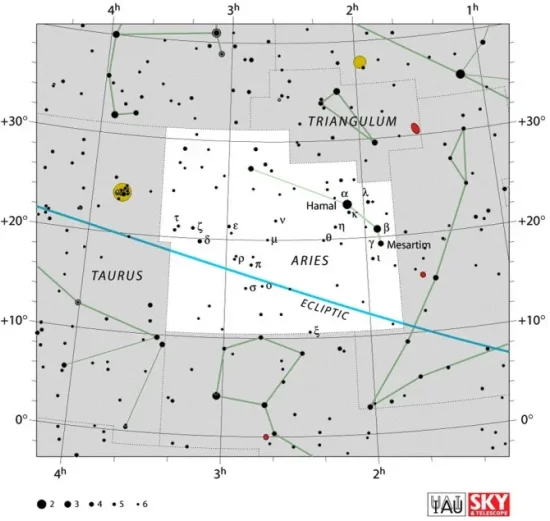
Aries constellation map by IAU and Sky&Telescope magazine
In addition to NGC 772 and the NGC 691 Group, Aries is home to several relatively bright deep sky objects. These include the elliptical galaxies NGC 770 and NGC 821, the colliding pair NGC 935 and IC 1801, and the dwarf irregular galaxy NGC 1156.
The best time of year to observe the stars and deep sky objects in Aries is during the month of December.
The 10 brightest stars in Aries are Hamal (Alpha Ari, mag. 2.00), Sheratan (Beta Ari, mag. 2.66), Bharani (41 Ari, mag. 3.63), Mesarthim (Gamma Ari, mag. 3.86), Botein (Delta Ari, mag. 4.349), HD 20644 (mag. 4.47), Lilii Borea (39 Ari, mag. 4.514), 35 Arietis (mag. 4.64), Lambda Arietis (mag. 4.79), and Zeta Arietis (mag. 4.89).
Sheratan – Beta Arietis
| Spectral class | A5 V |
| U-B colour index | +0.170 |
| B-V colour index | +0.142 |
| Apparent magnitude | 2.655 |
| Absolute magnitude | 1.55 ± 0.09 |
| Distance | 59.6 ± 0.8 light years (18.3 ± 0.3 parsecs) |
| Parallax | 54.74 ± 0.75 mas |
| Radial velocity | -1.9 km/s |
| Proper motion | RA: +98.74 mas/yr |
| Dec.: -110.41 mas/yr | |
| Mass (β Ari A, β Ari B) | 2.34 ± 0.10 M☉, 1.34 ± 0.07 M☉ |
| Luminosity (β Ari A, β Ari B) | 23 L☉, 1.3 L☉ |
| Temperature (β Ari A) | 9,000 K |
| Metallicity (β Ari A) | 0.16 dex |
| Age (β Ari A) | 0.3 billion years |
| Rotational velocity (β Ari A) | 73 km/s |
| Surface gravity (β Ari A) | 4.0 cgs |
| Constellation | Aries |
| Right ascension | 01h 54m 38.41099s |
| Declination | +20° 48′ 28.9133″ |
| Designations | Sheratan, Beta Arietis, β Ari, 6 Arietis, HD 11636, HR 553, HIP 8903, SAO 75012, GJ 80, FK5 66, BD +20°306, GC 2309, GCRV 1058, IRAS 01518+2033, 2MASS J01543840+2048291, PPM 91184, TYC 1212-1935-1, CCDM J01546+2048AB, WDS J01546+2049AB |
